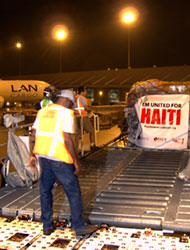- English
- Español
In Depth
Pan American Development Foundation: A month after the quake, Haiti needs to rebuild
 Thirty days after the catastrophic earthquake that killed more than 170,000 people in Haiti, the Pan American Development Foundation, the Organization of American States (OAS) and their partners renewed their efforts to get Haitians to work, to rebuild their homes and to take care of their families.
Thirty days after the catastrophic earthquake that killed more than 170,000 people in Haiti, the Pan American Development Foundation, the Organization of American States (OAS) and their partners renewed their efforts to get Haitians to work, to rebuild their homes and to take care of their families.
“It’s amazing how the Inter-American community has come together to support Haiti after this terrible tragedy,” says PADF Executive Director John Sanbrailo. “The extraordinary efforts during the first four weeks of the relief effort contributed to saving lives, strengthening local institutions and setting the stage for Haiti’s reconstruction.”
Once the earthquake struck, both the OAS and PADF reacted quickly to the crisis by providing cash, supplies and logistics. Within 48 hours, PADF was delivering materials from its office in the neighboring Dominican Republic to its staff in Haiti for distribution. Simultaneously, the OAS, its staff, and Member States, as well as the private sector-companies such as Chevron, Royal Caribbean International, Bacardi, among many others-donated hundreds of thousands of dollars making it possible for PADF to deliver by the end of January desperately needed food, water, shelter, medical care and hope to more than 35,000 people in key areas of Port-au-Prince and the Southeast province.
Dan O’Neil, PADF’s disaster relief coordinator in Port-au-Prince explains that the massive earthquake also hit home for PADF in Port au Prince where it had a full-time staff of more than 150 working in Haiti before the earthquake. “I've spent a lot of time listening to terrible stories from our staff. One employee's pregnant wife died. Another lost two kids,” O’Neil wrote just days after the 7.0 quake. “It took a long time to convince some of our staff to come back inside a concrete building. Half of our staff’s houses were damaged. I thought that the 100,000 death toll was an exaggeration. Instead, it was a low estimate. I can't imagine how Haiti will ever get back on its feet. We are all overwhelmed by the damage,” explained O’Neil who also recognized that in mid chaos and uncertainty almost all the workers and collaborators of the Foundation were back at work within days of the disaster. “I am very proud of our team,” he affirmed.
3,000 Jobs & “Tagging” Homes
Although providing relief will continue for a few months, PADF, along with its partners the OAS and Hollywood Unites for Haiti (HUFH), has initiated its recovery and reconstruction in key areas of Port-au-Prince and the Southeast province.
Starting the last week of February PADF will put to work 3,000 Haitians in a massive clean-up operation in areas such as Cite Soleil and Bel Air. PADF’s program, which uses funds from the World Bank that were provided to the Haitian government, will eventually employ 6,000 Haitians during six months.
In a separate program, on February 12 PADF started working, with leading earthquake recovery expert Kit Miyamoto on ‘tagging” homes, making structural assessments and formulating recommendations of safe access to the buildings in Port-au-Prince. The California-based structural engineer uses a high-tech inspection process to categorize buildings: “Green tag” means a home can be occupied; “Yellow tag” allows limited access until repairs are made; and a “Red tag” indicates that it is unsafe.
“Many engineers are red tagging buildings for destruction, but no one is placing the very vital green and yellow tags on homes that can be used,” says Sanbrailo. “Reassuring Haitians as to which homes are safe, as well as the rooms that may need to be repaired, is critical to getting people off the streets and into their homes.”
PADF’s goal is to inspect 20,000 buildings during the next few months, which Miyamoto will reach by training 50 Haitian engineers to use the technology. “If PADF obtains enough financial support, our goal is to expand the inspections, as well as provide proper guidance and construction materials so Haitians can repair and rebuild their homes,” says Sanbrailo.
Jimmy Jean-Louis, the actor and spokesperson for PADF-OAS-HUFH’s disaster relief and recovery efforts, says the focus on housing is key for Haiti. “Today, hundreds of thousands of people continue to live under tarps, bed sheets or simply out in the open,” says Jimmy Jean-Louis, who is also the founder and president of Hollywood Unites for Haiti. “We need to move survivors out of these miserable camps and into safe homes. I am asking people to contribute to this vital recovery and reconstruction phase.”
*******************
Individual and corporate donations to PADF-OAS-HUFH’s Haiti relief, recovery and reconstruction efforts are encouraged by calling toll-free in the U.S. (877) 572-4484 or visiting www.PanAmericanRelief.org. Text HEAL to 50555 in the U.S. to donate $5.
Separately, PADF has established a Solidarity Fund to help its staff get back on its feet. People who wish to donate to this special Solidarity Fund should send checks payable to PADF, note the Solidarity Fund and send them to its office on the Second Floor.
February, 2010


